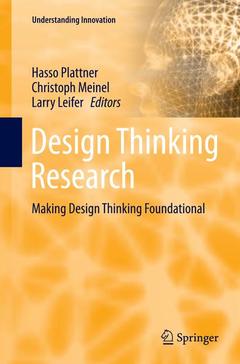Description
Design Thinking Research, 1st ed. 2016
Making Design Thinking Foundational
Understanding Innovation Series
Coordinators: Plattner Hasso, Meinel Christoph, Leifer Larry
Language: English
Subjects for Design Thinking Research:
Keywords
D-School; DTR; Design thinking; HPI; IT development; Innovating creativity
Design Thinking Research
Publication date: 10-2016
Support: Print on demand
Publication date: 10-2016
Support: Print on demand
Design Thinking Research
Publication date: 08-2015
290 p. · 15.5x23.5 cm · Hardback
Publication date: 08-2015
290 p. · 15.5x23.5 cm · Hardback
Description
/li>Contents
/li>Comment
/li>
This book summarizes the results of Design Thinking Research carried out at Stanford University in Palo Alto, California, USA and Hasso Plattner Institute in Potsdam, Germany. The authors offer readers a closer look at Design Thinking with its processes of innovations and methods. The contents of the articles range from how to design ideas, methods and technologies via creativity experiments and wicked problem solutions, to creative collaboration in the real world and the connectivity of designers and engineers. But the topics go beyond this in their detailed exploration of design thinking and its use in IT systems engineering fields and even from a management perspective. The authors show how these methods and strategies work in companies, introduce new technologies and their functions and demonstrate how Design Thinking can influence as diverse a topic area as marriage. Furthermore, we see how special design thinking use functions in solving wicked problems in complex fields. Thinking and creating innovations are basically and inherently human ? so is Design Thinking. Due to this, Design Thinking is not only a factual matter or a result of special courses nor of being gifted or trained: it?s a way of dealing with our environment and improving techniques, technologies and life.
Part I: Tools and Techniques for Improved Team Interaction.- Part II: Creativity and Creative Confidence.- Part III: Measuring Design Thinking.- Part IV: Documentation and Information Transfer in Design Thinking Processes.
Based on scientific evidence from the HPI Stanford Design Thinking Research Program Covers more than just best practice in design thinking and innovation Points out how design thinking can be used to innovate IT development
© 2024 LAVOISIER S.A.S.




